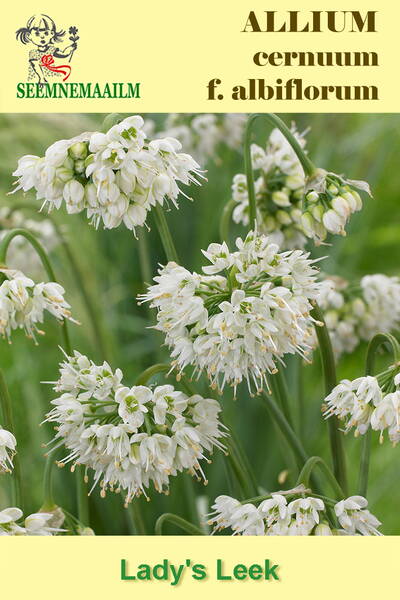Your shopping cart is empty!
Nodding white onion (lady's leek)
White Lady's leek (Nodding onion) - Allium cernuum f. albiflorum.
A decorative and long-lasting perennial with graceful fountains of drooping inflorescences.
Native to: North America and northern Mexico.
Drought-resistant. Winter hardiness zones: Z4 - Z9.
Flower color: white.
Foliage: thin, gray-green.
Height of flowering plant: 35-40 cm.
Natural flowering period: July - August.
Soil requirements: dry, moderately fertile.
1.0 g = 300 seeds.
A spectacular perennial onion for an alpine garden or the front edge of a mixborder, suitable for decorating meadows or plantings on the edge of a forest.
Dropping hemispherical umbrella-shaped inflorescences look spectacular against the background of gray-green graceful leaves. The leaves are edible.
Grows as a neat, beautiful bush. Outwardly similar to Allium nutans.
Characterized by late flowering, which begins in mid-summer, replacing the flowering of spectacular anzur onions.
Recommendations for sowing and care.
It is advisable to sow most ornamental onions before winter on a well-prepared breeding bed. When sowing in February-March, dig in the containers with crops on the bed, sprinkle with snow. In the process of gradual thawing of the soil substrate and the passage of melt water through it, the seed coat and the inhibitory layer that prevents rapid germination are destroyed. When a constant temperature is established within +5 +12 °C, friendly shoots appear.
Ornamental onions prefer the sun and well-drained soils, with the addition of lime. When propagated by seed, they bloom in 2-6 years.
Adult plants are also propagated by bulblets or division. They look great in small groups in rock gardens, as well as in mixed borders in a naturalistic style.
A decorative and long-lasting perennial with graceful fountains of drooping inflorescences.
Native to: North America and northern Mexico.
Drought-resistant. Winter hardiness zones: Z4 - Z9.
Flower color: white.
Foliage: thin, gray-green.
Height of flowering plant: 35-40 cm.
Natural flowering period: July - August.
Soil requirements: dry, moderately fertile.
1.0 g = 300 seeds.
A spectacular perennial onion for an alpine garden or the front edge of a mixborder, suitable for decorating meadows or plantings on the edge of a forest.
Dropping hemispherical umbrella-shaped inflorescences look spectacular against the background of gray-green graceful leaves. The leaves are edible.
Grows as a neat, beautiful bush. Outwardly similar to Allium nutans.
Characterized by late flowering, which begins in mid-summer, replacing the flowering of spectacular anzur onions.
Recommendations for sowing and care.
It is advisable to sow most ornamental onions before winter on a well-prepared breeding bed. When sowing in February-March, dig in the containers with crops on the bed, sprinkle with snow. In the process of gradual thawing of the soil substrate and the passage of melt water through it, the seed coat and the inhibitory layer that prevents rapid germination are destroyed. When a constant temperature is established within +5 +12 °C, friendly shoots appear.
Ornamental onions prefer the sun and well-drained soils, with the addition of lime. When propagated by seed, they bloom in 2-6 years.
Adult plants are also propagated by bulblets or division. They look great in small groups in rock gardens, as well as in mixed borders in a naturalistic style.












